Abstract
1. In order to examine the role of airway epithelium in the responsiveness of smooth muscle in man, we measured the contractile responses to acetylcholine (ACh), histamine, and prostaglandin F2 alpha (PGF2 alpha) and the relaxation response to isoprenaline (Isop), in 48 bronchi obtained from 10 patients who received surgery. Responses were measured in the presence and absence of the epithelium. 2. Removal of epithelium (by rubbing the mucosa gently with forceps) significantly increased the contractile responses evoked by ACh, histamine and PGF2 alpha. 3. In contrast, removal of epithelium did not alter the relaxation response to Isop. 4. To clarify the mechanism underlying this epithelial inhibitory effect on smooth muscle contraction, we measured the contractile responses of dog trachea with the epithelium removed to increasing concentrations of ACh. After measuring the control response, we added about 0.1 g of the chopped epithelium in the organ chamber, and measured the response again. 5. After adding airway epithelium and incubating with tracheal strips, the contractile response of tracheal strips decreased significantly as compared to the control response. 6. These results show that airway epithelium possesses the ability to decrease the smooth muscle contraction to ACh, histamine and PGF2 alpha in man and dogs. 7. The mechanism of this inhibitory effect of the airway epithelium is not explained by a change in mechanical property of the airway nor the change in diffusion of these drugs to the smooth muscle across the epithelium. Thus, these results suggest that airway epithelium may have an important role in modulating smooth muscle tone, possibly by inactivation of these mediators, or by releasing an epithelium-derived relaxing factor.
Full text
PDF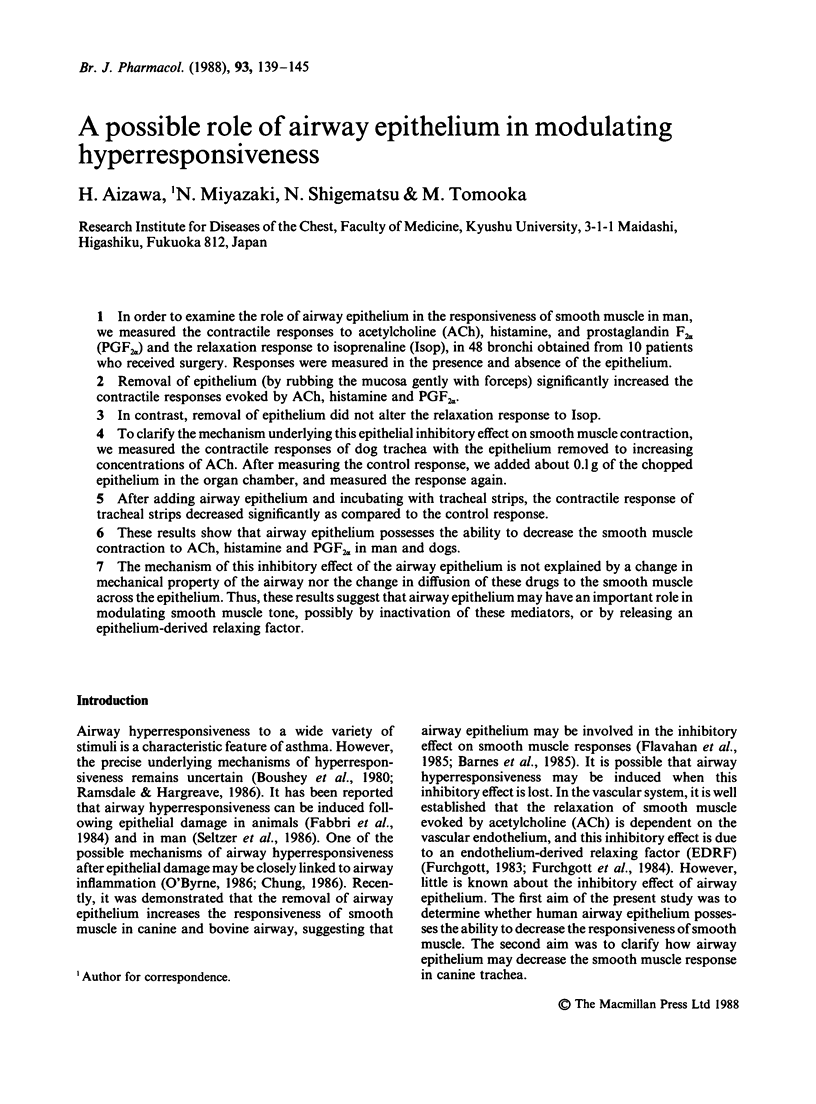

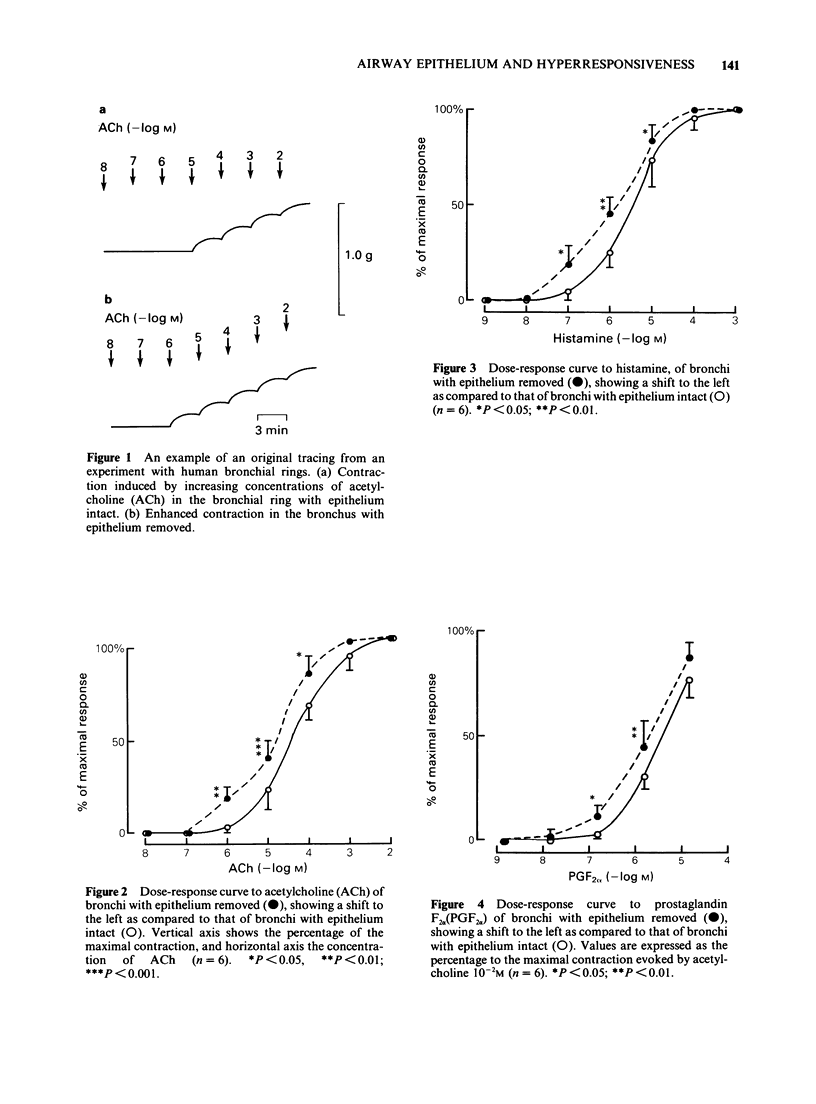
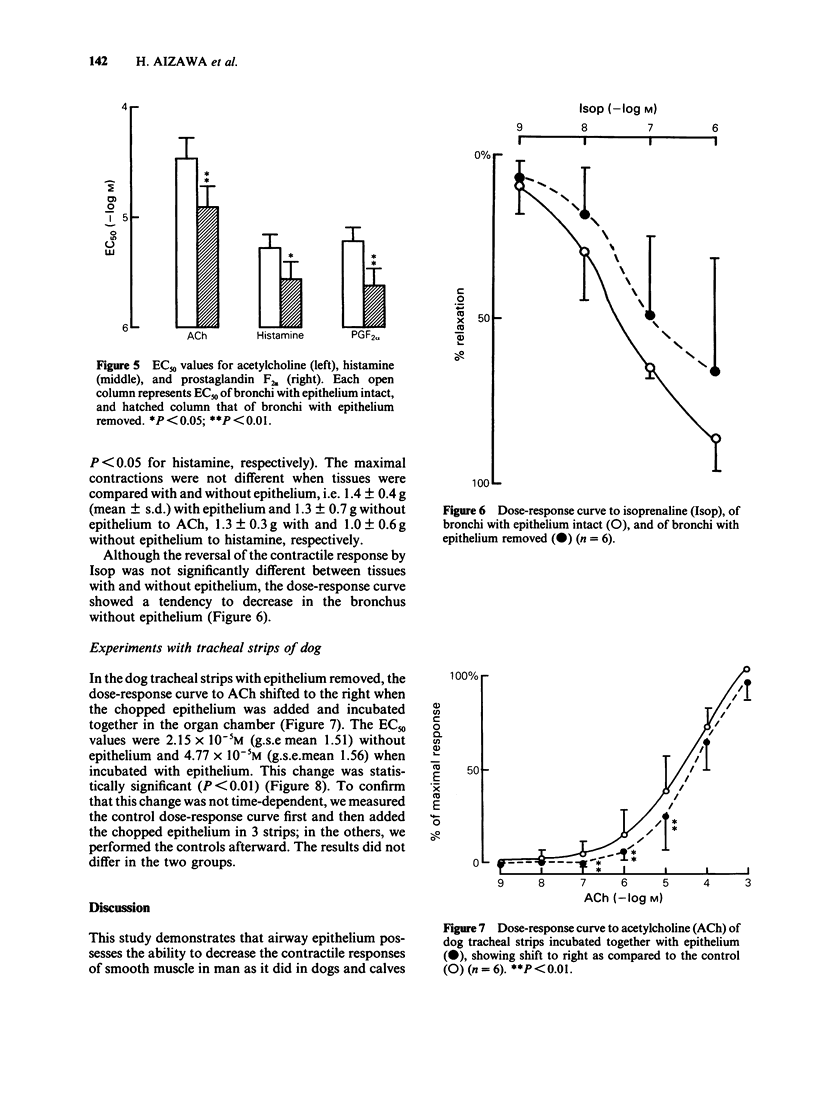
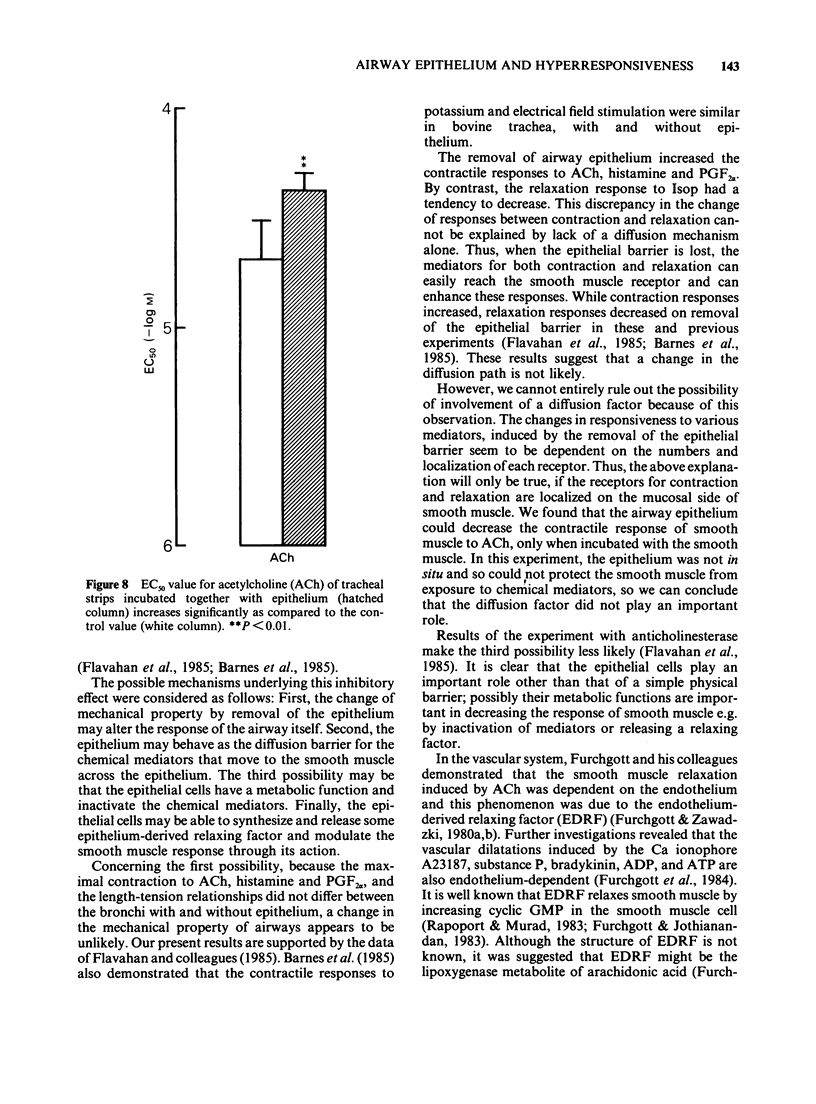
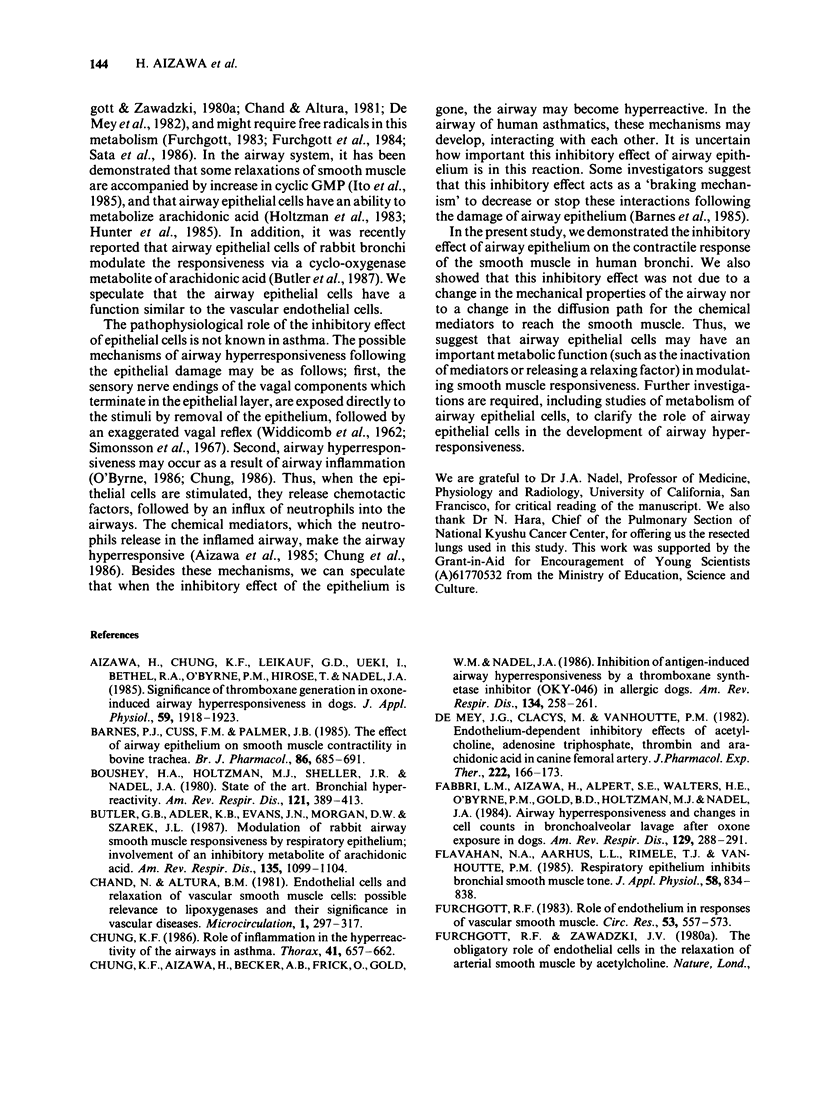
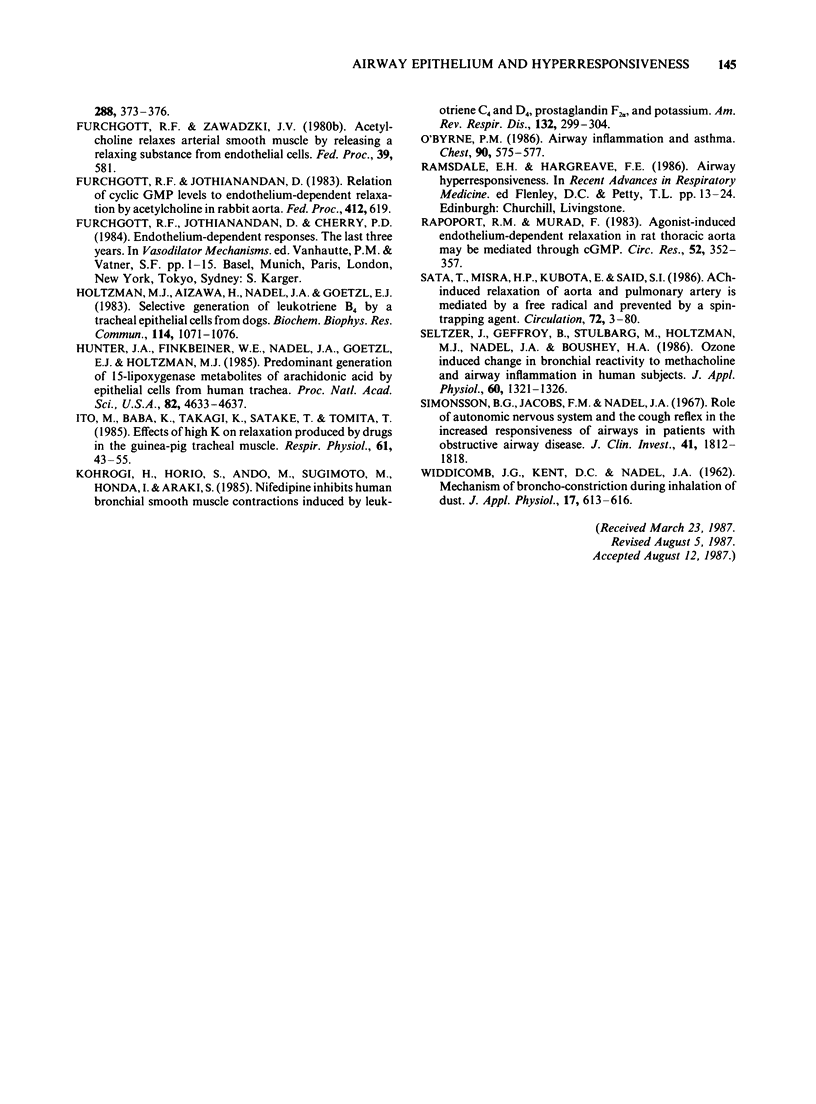
Selected References
These references are in PubMed. This may not be the complete list of references from this article.
- Aizawa H., Chung K. F., Leikauf G. D., Ueki I., Bethel R. A., O'Byrne P. M., Hirose T., Nadel J. A. Significance of thromboxane generation in ozone-induced airway hyperresponsiveness in dogs. J Appl Physiol (1985) 1985 Dec;59(6):1918–1923. doi: 10.1152/jappl.1985.59.6.1918. [DOI] [PubMed] [Google Scholar]
- Barnes P. J., Cuss F. M., Palmer J. B. The effect of airway epithelium on smooth muscle contractility in bovine trachea. Br J Pharmacol. 1985 Nov;86(3):685–691. doi: 10.1111/j.1476-5381.1985.tb08946.x. [DOI] [PMC free article] [PubMed] [Google Scholar]
- Boushey H. A., Holtzman M. J., Sheller J. R., Nadel J. A. Bronchial hyperreactivity. Am Rev Respir Dis. 1980 Feb;121(2):389–413. doi: 10.1164/arrd.1980.121.2.389. [DOI] [PubMed] [Google Scholar]
- Butler G. B., Adler K. B., Evans J. N., Morgan D. W., Szarek J. L. Modulation of rabbit airway smooth muscle responsiveness by respiratory epithelium. Involvement of an inhibitory metabolite of arachidonic acid. Am Rev Respir Dis. 1987 May;135(5):1099–1104. doi: 10.1164/arrd.1987.135.5.1099. [DOI] [PubMed] [Google Scholar]
- Chung K. F., Aizawa H., Becker A. B., Frick O., Gold W. M., Nadel J. A. Inhibition of antigen-induced airway hyperresponsiveness by a thromboxane synthetase inhibitor (OKY-046) in allergic dogs. Am Rev Respir Dis. 1986 Aug;134(2):258–261. doi: 10.1164/arrd.1986.134.2.258. [DOI] [PubMed] [Google Scholar]
- Chung K. F. Role of inflammation in the hyperreactivity of the airways in asthma. Thorax. 1986 Sep;41(9):657–662. doi: 10.1136/thx.41.9.657. [DOI] [PMC free article] [PubMed] [Google Scholar]
- De Mey J. G., Claeys M., Vanhoutte P. M. Endothelium-dependent inhibitory effects of acetylcholine, adenosine triphosphate, thrombin and arachidonic acid in the canine femoral artery. J Pharmacol Exp Ther. 1982 Jul;222(1):166–173. [PubMed] [Google Scholar]
- Fabbri L. M., Aizawa H., Alpert S. E., Walters E. H., O'Byrne P. M., Gold B. D., Nadel J. A., Holtzman M. J. Airway hyperresponsiveness and changes in cell counts in bronchoalveolar lavage after ozone exposure in dogs. Am Rev Respir Dis. 1984 Feb;129(2):288–291. [PubMed] [Google Scholar]
- Flavahan N. A., Aarhus L. L., Rimele T. J., Vanhoutte P. M. Respiratory epithelium inhibits bronchial smooth muscle tone. J Appl Physiol (1985) 1985 Mar;58(3):834–838. doi: 10.1152/jappl.1985.58.3.834. [DOI] [PubMed] [Google Scholar]
- Furchgott R. F., Jothianandan D., Cherry P. D. Endothelium-dependent responses: the last three years. Bibl Cardiol. 1984;(38):1–15. [PubMed] [Google Scholar]
- Furchgott R. F. Role of endothelium in responses of vascular smooth muscle. Circ Res. 1983 Nov;53(5):557–573. doi: 10.1161/01.res.53.5.557. [DOI] [PubMed] [Google Scholar]
- Holtzman M. J., Aizawa H., Nadel J. A., Goetzl E. J. Selective generation of leukotriene B4 by tracheal epithelial cells from dogs. Biochem Biophys Res Commun. 1983 Aug 12;114(3):1071–1076. doi: 10.1016/0006-291x(83)90671-x. [DOI] [PubMed] [Google Scholar]
- Hunter J. A., Finkbeiner W. E., Nadel J. A., Goetzl E. J., Holtzman M. J. Predominant generation of 15-lipoxygenase metabolites of arachidonic acid by epithelial cells from human trachea. Proc Natl Acad Sci U S A. 1985 Jul;82(14):4633–4637. doi: 10.1073/pnas.82.14.4633. [DOI] [PMC free article] [PubMed] [Google Scholar]
- Ito M., Baba K., Takagi K., Satake T., Tomita T. Effects of high K on relaxation produced by drugs in the guinea-pig tracheal muscle. Respir Physiol. 1985 Jul;61(1):43–55. doi: 10.1016/0034-5687(85)90027-1. [DOI] [PubMed] [Google Scholar]
- Kohrogi H., Horio S., Ando M., Sugimoto M., Honda I., Araki S. Nifedipine inhibits human bronchial smooth muscle contractions induced by leukotrienes C4 and D4, prostaglandin F2 alpha, and potassium. Am Rev Respir Dis. 1985 Aug;132(2):299–304. doi: 10.1164/arrd.1985.132.2.299. [DOI] [PubMed] [Google Scholar]
- O'Byrne P. M. Airway inflammation and airway hyperresponsiveness. Chest. 1986 Oct;90(4):575–577. doi: 10.1378/chest.90.4.575. [DOI] [PubMed] [Google Scholar]
- Rapoport R. M., Murad F. Agonist-induced endothelium-dependent relaxation in rat thoracic aorta may be mediated through cGMP. Circ Res. 1983 Mar;52(3):352–357. doi: 10.1161/01.res.52.3.352. [DOI] [PubMed] [Google Scholar]
- Seltzer J., Bigby B. G., Stulbarg M., Holtzman M. J., Nadel J. A., Ueki I. F., Leikauf G. D., Goetzl E. J., Boushey H. A. O3-induced change in bronchial reactivity to methacholine and airway inflammation in humans. J Appl Physiol (1985) 1986 Apr;60(4):1321–1326. doi: 10.1152/jappl.1986.60.4.1321. [DOI] [PubMed] [Google Scholar]
- Simonsson B. G., Jacobs F. M., Nadel J. A. Role of autonomic nervous system and the cough reflex in the increased responsiveness of airways in patients with obstructive airway disease. J Clin Invest. 1967 Nov;46(11):1812–1818. doi: 10.1172/JCI105671. [DOI] [PMC free article] [PubMed] [Google Scholar]
- WIDDICOMBE J. G., KENT D. C., NADEL J. A. Mechanism of bronchoconstriction during inhalation of dust. J Appl Physiol. 1962 Jul;17:613–616. doi: 10.1152/jappl.1962.17.4.613. [DOI] [PubMed] [Google Scholar]


